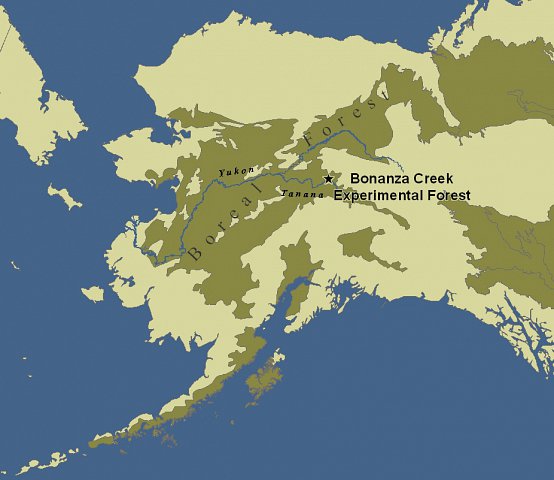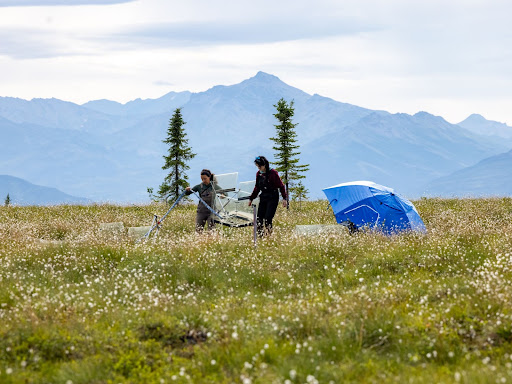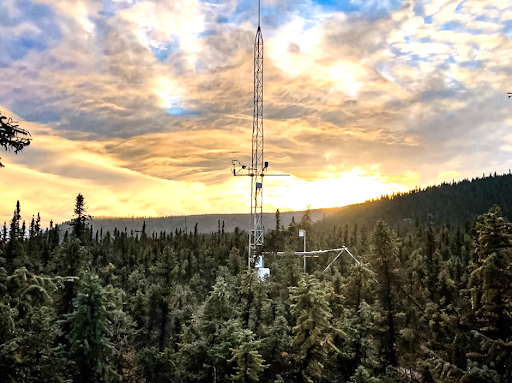Study Sites & Design: Overview
Our research is conducted in a number of sites that encompass a variety of landscape types and times since disturbance:
Bonanza Creek Experimental Forest (BCEF):
At the Bonanza Creek Experimental Forest (BCEF) we study ecosystem structure and function through the examination of controls over successional processes in taiga forests of Interior Alaska. We test hypotheses regarding controls on ecosystem succession with plots located in different stages of primary succession on the floodplain of the Tanana River, and in different stages of succession following wildfire.

Caribou-Poker Creek Research Watersheds (CPCRW):
The Caribou-Poker Creek Research Watershed (CPCRW) is a relatively pristine basin north of Fairbanks, Alaska reserved for ecological, hydrological, and climatic research. The CPCRW is the only research watershed in the United States located in the zone of discontinuous permafrost and is fairly representative of upland headwater stream basins in subarctic Alaska. Hydro-biological research in CPCRW has a few major emphases: assess the role of disturbance in the terrestrial landscape (i.e.,, wildfire, herbivory, logging) on subarctic stream ecosystems and the influence of discontinuous permafrost on freshwater ecology.
Regional Site Network (RSN):
The regional site network (RSN) sites were chosen to address variations in conditions driving the divergence of successional pathways and are located in three major ecoregions of Interior Alaska: the Ray Mountains, the Tanana-Kuskokwim Lowlands, and the Yukon-Tanana Uplands. These ecoregions have a strongly continental climate with cold winters and warm summers, discontinuous permafrost, and prevalent forest fires but differ in permafrost temperature, summer moisture, and dominance of forest fires.
Eight Mile Lake (EML):
The Eight Mile Lake study area (EML) is an upland tundra located in the northern foothills of the Alaska range. Permafrost temperatures in this region are currently ~ -1°C and therefore susceptible to thaw. Research at EML is focused on a permafrost thaw gradient (minimal, moderate, and extensive thaw) and a long-term permafrost heating experiment. Core measurements at EML include soil temperature, moisture, thaw depth, water table depth, and carbon dioxide fluxes. We also measure plant productivity and phenology, soil and plant nutrient status, methane fluxes, and stable and radioactive carbon isotopes in plants and soils.

Photo credit: NAU photography
Alaska Peatland Experiment (APEX):
The Alaska Peatland Experiment (APEX) includes a series of peatland sites near the BNZ Experimental Forest that have been studied by BNZ LTER researchers for the past 20 years. Since 2005, we have maintained water table manipulations in a rich fen to study the effects of flooding and drought on peatland vegetation and carbon cycling. More recently, we initiated a new series of plant community manipulations within the water table manipulation plots to test our understanding of rhizosphere controls on aerobic and anaerobic microbial processes. APEX sites also include a nearby forested peatland plateau underlain by permafrost and a series of thermokarst bogs ranging in time-since-thaw. Rapid permafrost thaw and active layer deepening has been documented in the permafrost plateau since 2014. At all sites we monitor eddy covariance and chamber-based greenhouse gas fluxes, vegetation change, and hydrologic change. The APEX site is a resource for using large-scale experimental approaches to study controls on peatland carbon cycling, but our infrastructure and data also have been used to validate new remote sensing applications, geophysical techniques, and regional to global modeling exercises.

Photo credit: Jack McFarland (USGS)
 B
B

